About the Laboratory
Current Work: HAYSTAC and ALPHA
We are studying the properties of the Universe and the fundamental laws of physics using small-scale tabletop experiments. The principal activity is presently a search for galactically-bound cold dark matter (CDM), the Haloscope At Yale Sensitive To Axion CDM (HAYSTAC). This effort is supported by the Heising-Simons Foundation, by the National Science Foundation, and by Yale University.
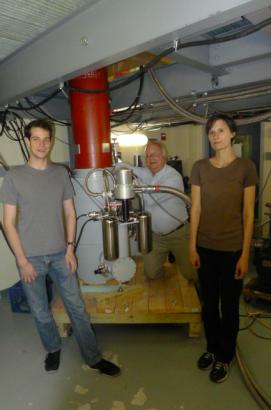
The red can is a cryostat that contains an external-cryogen-free dilution refrigerator which cools the microwave cavity to about 0.12 K. The gray can is a separate cryostat that contains a 9 Tesla superconducting magnet. More details of the experiment are provided on the Research pages of this website.
The system was upgraded, incorporating a squeezed state receiver designed by Prof. Konrad Lehnert’s group at Univ. Colorado, in 2019. We called this HAYSTAC Phase II. We also moved the experiment to a Blue Fors LD-250 dilution refrigerator acquired in 2015.
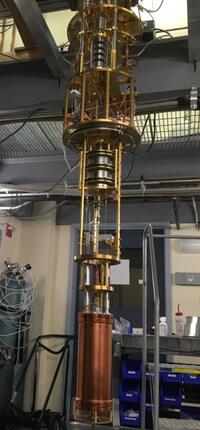 This is a photograph of the insert. The very top section carries the dilution refrigerator plumbing, the next section is where the microwave components are mounted. Underneath this section is an aluminum hoop that carries a superconducting coil that shields the microwave components from the full field of the magnet. The silver can underneath is a multilevel magnetic shield that houses two Josephson Parametric Amplifiers, one serves to generate a squeezed state, while the second is a phase-sensitive amplifier adjusted to amplify the squeezed component. Hanging from the very bottom is the tunable microwave cavity where the axion conversion to photons occurs—the gantry from which the cavity hangs is made of high thermal conductivity copper rods.
This is a photograph of the insert. The very top section carries the dilution refrigerator plumbing, the next section is where the microwave components are mounted. Underneath this section is an aluminum hoop that carries a superconducting coil that shields the microwave components from the full field of the magnet. The silver can underneath is a multilevel magnetic shield that houses two Josephson Parametric Amplifiers, one serves to generate a squeezed state, while the second is a phase-sensitive amplifier adjusted to amplify the squeezed component. Hanging from the very bottom is the tunable microwave cavity where the axion conversion to photons occurs—the gantry from which the cavity hangs is made of high thermal conductivity copper rods.
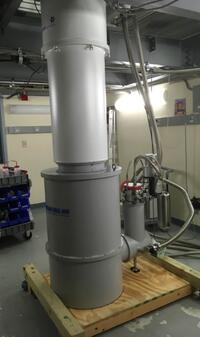 This is a photograph of the DR/Cavity inserted into the superconducting magnet. The lab has two levels, with the electronics on the upper level, away from the 9 Tesla magnetic field that falls off quite rapidly with distance.
This is a photograph of the DR/Cavity inserted into the superconducting magnet. The lab has two levels, with the electronics on the upper level, away from the 9 Tesla magnetic field that falls off quite rapidly with distance.
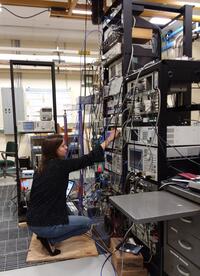
Kelly Backes (Ph.D. 2021) is shown adjusting the squeezed state microwave receiver.
Other changes include an Attocube piezoelectric motor to adjust the cavity frequency.
We are currently in Phase III of HAYSTAC after incorporating further improvements, including parallel processing on an Nvidia graphics card for the Fourier transform of the raw signal.
Note from SKL: After seeing the Samuel Beckett play Endgame at the Longwharf Theater in New Haven in Jan. 2017, I realized that I am also in an endgame, cast as Clov and the HAYSTAC detector is Hamm
https://www.nhregister.com/entertainment/article/Brian-Dennehy-tackles-his-Matterhorn-11317638.php
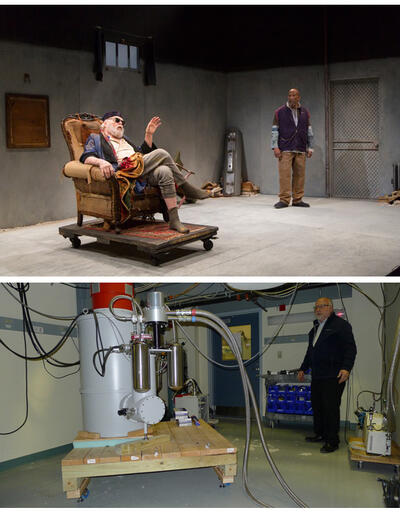
Previous Efforts
In past years, we had two main experimental projects located at Yale. One was a search for the permanent electric dipole moment (EDM) of the electron. The electron EDM can only exist if the laws of physics violate time-reversal and parity symmetries. The existence of such an EDM at a measurable level is predicted by several particle-physics theories beyond the standard model of electroweak interactions, such as Supersymmetry. The other project was a study of the Casimir force. This is a force between two bodies due to quantum vacuum fluctuations around and in between these bodies. We used a torsion pendulum apparatus to study this force under various conditions. The Casimir measurement apparatus is still functional, awaiting a new project.
